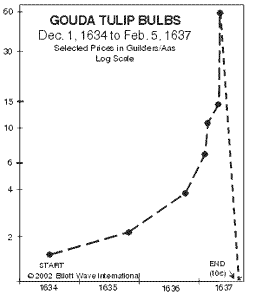By Jesse Colombo (This article was written on June 15th, 2012)
 Tulips have long held a significant role in Dutch history and culture ever since they were introduced to the Netherlands from the Ottoman Empire in the mid-1500s. So strong was the Dutch love affair with tulips during the Dutch Golden Age of the mid-1600s that a tulip bulb bubble or "Tulip Mania" even occurred. Generally considered to be the first recorded financial bubble, the Tulip Mania of 1636-1637 was an episode in which tulip bulb prices were propelled by speculators to incredible heights before collapsing and plunging the Dutch economy into a severe crisis that lasted for many years.
Tulips have long held a significant role in Dutch history and culture ever since they were introduced to the Netherlands from the Ottoman Empire in the mid-1500s. So strong was the Dutch love affair with tulips during the Dutch Golden Age of the mid-1600s that a tulip bulb bubble or "Tulip Mania" even occurred. Generally considered to be the first recorded financial bubble, the Tulip Mania of 1636-1637 was an episode in which tulip bulb prices were propelled by speculators to incredible heights before collapsing and plunging the Dutch economy into a severe crisis that lasted for many years.
Events Leading Up to the Tulip Bulb Bubble
The Golden Century is the name of the period in Dutch history between 1600 and 1700 when the port city of Amsterdam was one of the richest of all cities in Western Europe due to its strong role in international trade. Trading companies such as the VOC (Verenigde Oost-Indische Compagnie), commonly known as the Dutch East India Company, became dominant players in the Netherlands’ trade with Indonesia and other far-away lands. Amsterdam’s booming economy led to a flourishing of the arts and architecture, as well as trade in blue glass, china and other luxury goods.
Dutch trade with foreign lands led to the importation of exotic goods that were never seen before by Europeans. Tulips were first introduced to Europe from Turkey when a sultan sent bulbs and seeds to Vienna. Shortly after 1554, these seeds were sent to Amsterdam, where their popularity began to rise. A university study in 1593 led to the discovery that tulips could withstand the harsh northern-European climate, which further boosted their desirability in the Netherlands. With their intensely colorful petals, tulips were unlike any other flower popular in Europe at that time and having tulips growing in one’s garden became an important status symbol (The Tulipomania, n.d).
Tulip plants originate in the form of tulip bulbs which do not flower until seven to twelve years later. Between April and May, tulips bloom for about one week, with bulbs appearing between June and September, thus confining Dutch sales to that season. A rudimentary derivatives market, similar to modern-day options and futures contracts, eventually arose so that traders could conduct trade in tulips all year round. Traders entered into tulip contracts by signing contracts for future tulip purchases before a notary. The very active tulip contract market eventually became an integral part of the overall booming Dutch tulip industry.
As the Dutch tulip market became increasingly sophisticated, tulips were classified into groups and priced according to their rarity. In general, solid-colored tulips were worth less than those with multiple colors. Couleren was the classification for solid-colored red, white, or yellow tulips, rosen referred to multi-colored tulips, often red, pink, or white and violetten described the white tulips with purple or lilac on them. Bizarden were the most popular tulips, with a yellow background and red, brown, or purple coloration (Allan Bellows, 2012). Tulips that were infected with the benign mosaic virus, which caused "flames" of color to appear upon the petals, sold at a premium due to their unique beauty and rarity (Investopedia, 2012).
The Mania Phase

Tulip prices steadily rose with their growing popularity and bulbs were purchased at higher and higher prices by speculators who planned to turn around and sell them for a profit, similar to modern-day house "flippers." From 1634 to 1637, an index of Dutch tulip prices (see chart above) soared from approximately one guilder per bulb to a lofty sixty guilders per bulb. Traders who sold their bulbs for a profit began to reinvest all of their profit into new tulip bulb contracts or new bulbs to sell to other Dutch citizens or to take with them on trips around the world to sell alongside with spices from the Dutch East India Company. Many merchants sold all of their belongings to purchase a few tulip bulbs for the purpose of cultivating and selling them for more profit than they could have ever made in a lifetime as a merchant. As the tulip bulb bubble crescendoed, already pricey tulip bulbs experienced a twentyfold price explosion in just a single month (Investopedia, 2012). By the peak of tulipmania in February of 1637, a single tulip bulb was worth about ten times a craftsman’s annual income and a single Viceroy tulip bulb was allegedly exchanged for the following goods (The Tulipomania, n.d):
- Two lasts of wheat
- Four lasts of rye
- Four fat oxen
- Eight fat swine
- Twelve fat sheep
- Two hogsheads of wine
- Four tuns of beer
- Two tons of butter
- 1,000 lb. of cheese
- A complete bed
- A suit of clothes
- A silver drinking cup
Successful Dutch tulip bulb traders, the archaic counterparts to the day traders of the late 1990s Dot-com bubble and the house flippers of the mid-2000s U.S. housing bubble, could earn up to 60,000 florins in a month– approximately $61,710 in current U.S. dollars (Allan Bellows, 2012). Tulip bulb speculation became so widespread by 1636 that they were traded on Amsterdam’s Stock Exchange and in Rotterdam, Haarlem, Leyden, Alkmar, Hoorn, and other towns. Around the same time, tulip speculation even spread to Paris and England, where tulips were traded on the London Stock Exchange. In both cities, traders strove to push tulip prices up to the lofty levels seen in Amsterdam but were only moderately successful in their attempt (The Tulipomania, n.d).
Astronomically-high tulip bulb prices resulted in some equally astonishing anecdotes such as the sailor who mistakenly ate an extremely rare Semper Augustus tulip bulb thinking it was an onion. This "onion" was so valuable that it could have fed his whole ship’s crew for an entire year. The hapless sailor was jailed for several months for his innocent but costly mistake. Another similar anecdote is of an traveling English botanist who was unaware of the Dutch tulip mania of the time, who peeled and dissected a wealthy Dutchman’s four thousand florin Admiral Von der Eyk tulip bulb mistaking it for an unusual species of onion. The bewildered English traveller was quickly led through the streets, followed by a mob, to be brought before a judge who sentenced him to prison until he could pay for the damage (The Tulipomania, n.d).
The Crash
Like all bubbles, the Dutch tulip bulb bubble continued to inflate beyond people’s wildest expectations until it abruptly "popped" in the winter of 1636-37. A default on a tulip bulb contract by a buyer in Haarlem was the main bubble-popping catalyst and caused the tulip bulb market to violently implode as sellers overwhelmed the market and buyers virtually disappeared altogether. Some traders attempted to support prices, to no avail. Within just a few days, tulip bulbs were worth only a hundredth of their former prices, resulting in a full-blown panic throughout Holland. Dealers refused to honor contracts, further damaging confidence in the tulip bulb market. Eventually, the government attempted to stem the the tulip market meltdown by offering to honor contracts at 10% of their face value, which only caused the market to plunge even further. The brutal popping of the tulip bulb bubble ended the Dutch Golden Age and hurled the country into a mild economic depression that lasted for several years. The traumatic tulip bulb crash resulted in a suspicion toward speculative investments in Dutch culture for a very long time after. (One also has to wonder if this is how the Dutch reputation for frugality arose!)
Related Web Resources:
Market Crashes: The Tulip and Bulb Craze
The Dutch Tulip Bubble of 1637
The Tulipomania: An Investing Bubble
References:
Allan Bellows. (2012). The Dutch Tulip Bubble of 1637. Retrieved 15th April 2012, from http://www.damninteresting.com/the-dutch-tulip-bubble-of-1637/
Investopedia.(2012). The Greatest Market Crashes. Retrieved on 17th April, 2012, from http://www.investopedia.com/features/crashes/crashes2.asp
The Tulipomania. (n.d.). Tulipmania and Investing. Retrieved on 16th April, from, http://www.thetulipomania.com/

